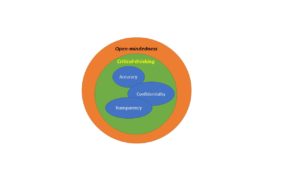Cisco Systems Survival in the “Age of China”

John Chambers, former CEO, lays the foundation of Cisco’s long-term success and profitability
For any one who works actively within the Information Technology (IT) arena, the company synonymous with the Internet’s backend infrastructure is Cisco Systems. It produces most of the world’s major infrastructure hardware devices such as firewalls, routers, and bridges. These devices are critical to the creation and maintenance of the global Internet.
Even after the “dot-com” burst of 1997-2003 (Business Insider, 2010), it recovered exceptionally, and has continued to be a major manufacturer of critical network devices found as the foundational elements of most of any company’s IT network. “As of [2018], Cisco generates revenues of over $49 billion and has dominant positions in 18 different IT product lines” (Taulli, 2018). Cisco’s post “dot-com” bubble success can be attributed directly to Cisco’s senior leadership and their strategy that ensured its long-term ability to remain competitive and profitable.
Strategic Leadership Focus
There are many sources (McGregor, 2018) (Swartz, 2018) (Taulli, 2018) that place the direct and current success of Cisco on recently retired, Chief Executive Officer John Chambers. It was his strategic leadership that ensured Cisco’s long-term viability in a highly-specialized segment of the IT marketplace. Chamber’s approach can be enumerated by three major strategies: “…find ways to innovate to scale, build a culture that is focused on the needs of the customer and develop a flexible network infrastructure [for its customers]” (Taulli, 2018). These strategies continue to support its market profitability with a current corporate valuation of $216 billion (Swartz, 2018).
“Strategic leadership is about how to most effectively manage a company’s strategy-making process to create competitive advantage” (Hill, Schilling, & Jones, 2017). Chamber’s three tenets do exactly that. They provide the vision and focus to create a common understanding of leadership’s approach to creating a competitive position in the market. Tenet one, “innovating to scale,” understands that not one device can be applied equally across differing markets, for example, medical, business, finance, and especially small business; cost concerns and capability are a key concern for any segment of industry. “Focusing on the needs of the customer” directly supports the first tenet; if you do not understand the variability across the customer base, it may result in lost revenues in certain markets that do not feel their needs are adequately being met by the products produced. Finally, developing “flexible network options” also reinforces the main strategy. Cisco has not only implemented a strong and mutually supportive strategy for its competitiveness but has clearly sustained its leadership position based upon its continuing primacy in the IT back-end hardware environment.
Cisco’s Analysis of Internal and External Factors
The most common approach to analyzing internal and external factors impacting how Cisco has managed its long-term competitiveness is by using a Strengths-Weaknesses- Opportunities-Threat (SWOT) analysis. While the actual analysis is typically restricted, and not accessible in the public domain, there are many SWOT analyses done from the complex to the basic. An uncomplicated analysis was accomplished by Washburn University in 2016 that can be found at Figure 1.

Figure 1. Cisco SWOT Analysis. Adapted from “Cisco” by A. Boyd, B. Smith, D.M. Poletti, S. Specht, 2016, Washburn University, p. 23. No Copyright 2016 by Washburn University.
Internal analysis begins with a review of a company’s resources, capabilities, and competencies (Hill, Schilling, & Jones, 2017). These are typically identified in a SWOT analysis by the strengths and weaknesses quadrants specific to its internal operations. As suggested in Figure 1, a key internal strength can be found in its capabilities to include a diversified product line that does not only include network hardware devices.
In 2017, software accounted for 22% of Cisco’s overall revenues (Morningstar, 2018). This strength continues to be a focus in 2019 because of the ongoing commercial demands for specialized software in the IT back office management area. Cisco’s focus on software remains a vital part of its ability to anticipate and to attempt to lead (Chambers, 2015) through such transitions, for example, ongoing volatility in the data center development market. It is this strength that Cisco continues align with its founding strategies to innovate and focus on the needs of the customer, and to ensure its continuing profitability.
The opportunities and threats quadrants of a SWOT analysis help to derive external environmental factors impacting profits. Morningstar analysis (Morningstar, 2018) of Cisco Systems recognizes that its major opportunity for continued profitability relies upon its brand loyalty. This loyalty factor is very high, and customers recognize that switching costs to other vendors are risky and cost prohibitive.
Cisco would also conduct its external analysis based upon Porter’s Five Forces model (Hill, Schilling, & Jones, 2017). The “bargaining power of buyers” provides a major advantage to Cisco. Cisco recognizes that that the back-end network infrastructure community is “…inherently risk averse…” (Morningstar, 2018, p. 2), and have leveraged this understanding where it can charge premium prices based upon it; changes in equipment may have unforeseen impacts on customer operations, and many of the current Cisco-based infrastructure companies are not willing to make decisions that affect their own profitability.
The sample, Figure 1, SWOT analysis is basic in its consideration of economic threats to any company. Political and currency risks are common risks. They are the “known-knowns” of risk. These are universal risks when selling goods and services in global markets with differing economies and political structures.
A major flaw not anticipated by Porter (Hill, Schilling, & Jones, 2017) is economic espionage and its impacts on markets. Nowhere can that be seen more greatly is the brazen and continued spying efforts by China. As recently as 2019, federal prosecutors were pursuing criminal investigations of Chinese companies stealing trade secrets from both the U.S. and its trading partners (Hong, Strumpf, & Viswantha, 2019). It is an imbalance of rivalries among companies that have access to a nation-states political and intelligence apparatus. Cisco, as well as its competitors, face an extra-daunting task to compete fairly in the global market; China is a specific threat of the Twenty-first Century not addressed, for example, by Porter.
Additionally, such an external threat not only poses challenges to the
While there are several foreign IT equipment and software companies that have been accused of such activities, the major threat in this arena is the Chinese company Huawei (Wah-way) Technologies Company, Limited. In 2012, the House Permanent Select Committee on Intelligence had major concerns. Specific to its investigation of the operating practices of Huawei, the committee reported that: “The threat posed [by Huawei/China] to U.S. national-security interests… in the telecommunications supply chain is an increasing priority…” (U.S. house of representatives, 2012, p. 1).
Huawei represents a similar and more pervasive threat to the international IT supply chain and creates an even greater risk to Cisco and other like market competitors. Huawei has both the means and motives to compromise IT equipment and systems on the behalf of the Chinese government. Furthermore, Huawei has refused to explain its relationship with the Chinese government or the role of the Chinese Communist Party (Simonite, 2012), and it can be assumed, based on multiple Huawei senior leaders with close ties with the People’s Liberation Army (PLA), that Huawei has an explicit connection with the Chinese government.
Porter did not adequately consider how corporate espionage may impact the overall success of a company. He did not consider or anticipate the massive resources of a nation is applied to overwhelm it in the global marketplace. China, as a macro-threat in the marketplace, should be additionally considered as well as other dictatorial governments with capabilities to exploit the Internet as has China over many years.
Conclusion
References
Business Insider. (2010, December 15). Here’s why the dot com bubble began and why it popped. Retrieved from Business Insider: https://www.businessinsider.com/heres-why-the-dot-com-bubble-began-and-why-it-popped-2010-12
Chambers, J. (2015, May). Cisco’s CEO on staying ahead of technology shifts. Retrieved from Harvard business review: https://hbr.org/2015/05/ciscos-ceo-on-staying-ahead-of-technology-shifts
Director of National Intelligence. (2015, February 26). Statement of record: Worldwide threat assessment. Retrieved from http://www.armed-services.senate.gov/imo/media/doc/Stewart_02-26-15.pdf
Hill, C. W., Schilling, M. A., & Jones, G. R. (2017). Strategic management: An integrated approach : theory & cases. Boston: Cengage learning.
Hong, N., Strumpf, D., & Viswantha, A. (2019, January 16). Huawei targeted in U.S. criminal probe for alleged theft of trade secrets. Retrieved from Wall street journal: https://www.wsj.com/articles/federal-prosecutors-pursuing-criminal-case-against-huawei-for-alleged-theft-of-trade-secrets-11547670341
McGregor, J. (2018, September 14). Former Cisco CEO John Chambers wants to make America a start-up nation again. Retrieved from Washinton post: https://www.washingtonpost.com/business/2018/09/14/former-cisco-ceo-john-chambers-wants-make-america-start-up-nation-again/?utm_term=.5660202edf72
Morningstar. (2018, November 15). Cisco systems inc. Retrieved from Morningstar Investment Research database
Simonite, T. (2012, October 9). Why the united states is so afraid of huawei. Retrieved from MIT technology review: http://www.technologyreview.com/news/429542/why-the-united-states-is-so-afraid-of-huawei/
Swartz, J. (2018, August 23). After cisco, john chambers is still dreaming big about tech. Retrieved from Barron’s: https://www.barrons.com/articles/after-cisco-john-chambers-is-still-dreaming-big-about-tech-1535046077
Taulli, T. (2018, October 20). Leadership lessons from cisco’s john chambers. Retrieved from Forbes: https://www.forbes.com/sites/tomtaulli/2018/10/20/leadership-lessons-from-ciscos-john-chambers/#2d202e8a4240
U.S. House of Representatives. (2012, October 8). Investigative report on the US national security issues posed by chinese telecommunications companies huawei and ZTE. Retrieved from https://intelligence.house.gov/sites/intelligence.house.gov/files/documents/Huawei-ZTE%20Investigative%20Report%20(FINAL).pdf
Suggested Reading on China’s 100-Hundred Year “Marathon” Against the West

Dr. Russo is currently the Senior Data Scientist with Cybersenetinel AI in Washington, DC. He is a former Senior Information Security Engineer within the Department of Defense’s (DOD) F-35 Joint Strike Fighter program. He has an extensive background in cybersecurity and is an expert in the Risk Management Framework (RMF) and DOD Instruction 8510, which implement RMF throughout the DOD and the federal government. He holds a Certified Information Systems Security Professional (CISSP) certification and a CISSP in information security architecture (ISSAP). He has a 2017 Chief Information Security Officer (CISO) certification from the National Defense University, Washington, DC. Dr. Russo retired from the US Army Reserves in 2012 as a Senior Intelligence Officer.










